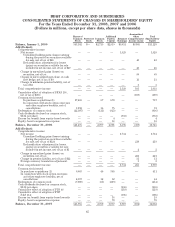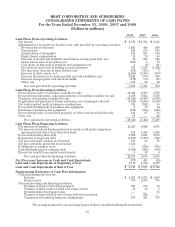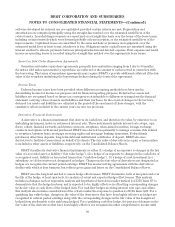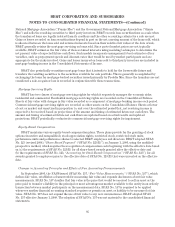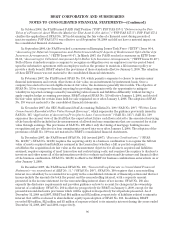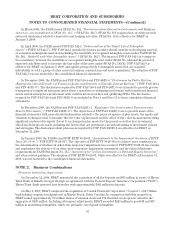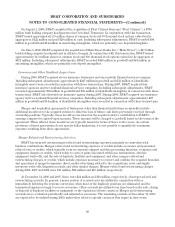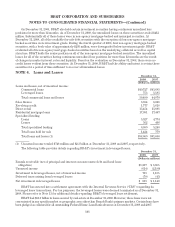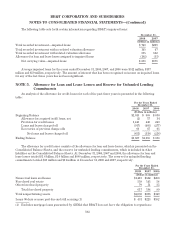BB&T 2008 Annual Report Download - page 92
Download and view the complete annual report
Please find page 92 of the 2008 BB&T annual report below. You can navigate through the pages in the report by either clicking on the pages listed below, or by using the keyword search tool below to find specific information within the annual report.BB&T CORPORATION AND SUBSIDIARIES
NOTES TO CONSOLIDATED FINANCIAL STATEMENTS—(Continued)
Assets acquired as a result of foreclosure are carried at the lower of cost or net realizable value. Net
realizable value equals fair value less estimated selling costs. Cost is determined based on the sum of unpaid
principal, accrued but unpaid interest if not required to be reversed and acquisition costs associated with the loan.
Any excess of cost over net realizable value at the time of foreclosure is charged to the allowance for loan and
lease losses. Generally, such properties are valued periodically and if the carrying value is greater than the net
realizable value, a valuation reserve is established. Routine maintenance costs, declines in market value and net
losses on disposal are included in other noninterest expense.
Allowance for Loan and Lease Losses and Reserve for Unfunded Lending Commitments
The allowance for loan and lease losses and reserve for unfunded lending commitments are management’s
best estimate of probable credit losses that are inherent in the loan and lease portfolios and off-balance sheet
lending commitments at the balance sheet date. The Company determines the allowance for loan and lease losses
and the reserve for unfunded lending commitments based on an ongoing evaluation. This evaluation is inherently
subjective because it requires material estimates, including the amounts and timing of cash flows expected to be
received on impaired loans. Those estimates are susceptible to significant change. Changes to the allowance for
loan and lease losses and the reserve for unfunded lending commitments are made by charges to the provision for
credit losses, which is reflected in the Consolidated Statements of Income. Loans or lease balances deemed to be
uncollectible are charged off against the allowance for loan and lease losses. Recoveries of amounts previously
charged-off are credited to the allowance for loan and lease losses.
The allowance for loan and lease losses is the accumulation of various components that are calculated based
on various methodologies. BB&T’s allowance for loan and lease losses consists of (1) a component for individual
loan impairment recognized and measured pursuant to SFAS No. 114, “Accounting by Creditors for Impairment
of a Loan,” (“SFAS No. 114”), and (2) components of collective loan impairment recognized pursuant to SFAS
No. 5, “Accounting for Contingencies,” (“SFAS No. 5”).
BB&T maintains specific reserves for individually impaired loans pursuant to SFAS No. 114. A loan is
impaired when, based on current information and events, it is probable that BB&T will be unable to collect all
amounts due (interest as well as principal) according to the contractual terms of the loan agreement. Specific
reserves are determined on a loan by loan basis based on management’s best estimate of BB&T’s exposure, given
the current payment status of the loan, the present value of expected payments and the value of any underlying
collateral.
Management’s estimate of reserves established pursuant to the provisions of SFAS No. 5 for collective
impairment reflect losses inherent in the loan and lease portfolios as of the balance sheet reporting date.
Embedded loss estimates are based on current migration rates and current risk mix. Embedded loss estimates
may be adjusted to reflect current economic conditions and current portfolio trends including credit quality,
concentrations, aging of the portfolio, and significant policy and underwriting changes.
The methodology used to determine the reserve for unfunded lending commitments is inherently similar to
that used to determine the SFAS No. 5 component of the allowance for loan and lease losses described above,
adjusted for factors specific to binding commitments, including the probability of funding and exposure at default.
While management uses the best information available to establish the allowance for loan and lease losses
and the reserve for unfunded lending commitments, future adjustments may be necessary if economic conditions
differ substantially from the assumptions used in performing the valuations or, if required by regulators, based
upon information available to them at the time of their examinations.
Premises and Equipment
Premises, equipment, capital leases and leasehold improvements are stated at cost less accumulated
depreciation or amortization. Land is stated at cost. In addition, purchased software and costs of computer
92





